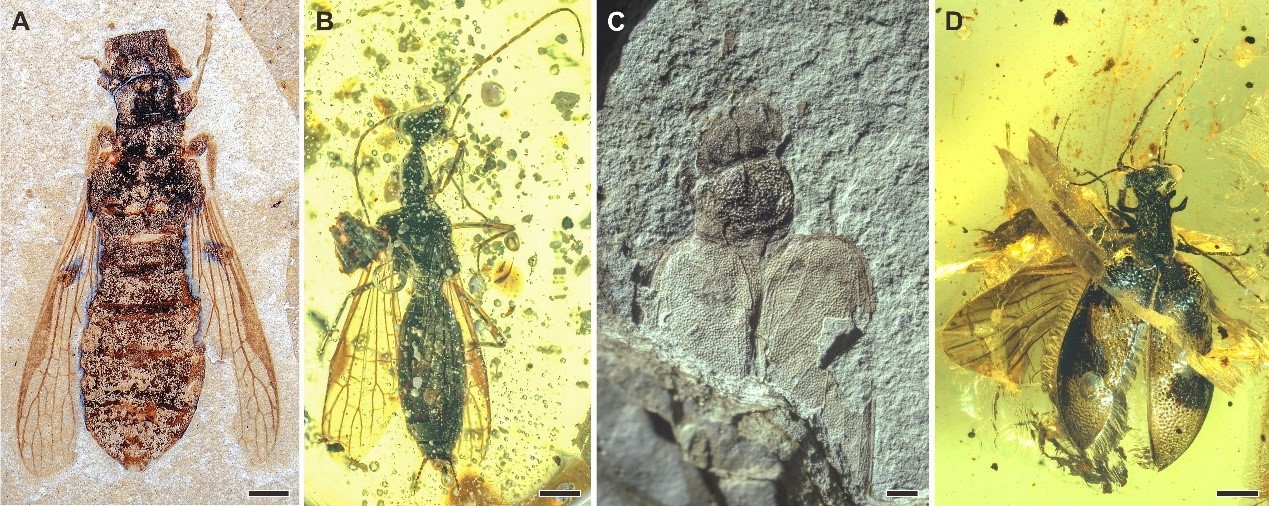Myrmecomorphy is a phenomenon in which some animals mimic ants morphologically and behaviorally, and belongs to a special kind of anthropomorphic behavior, which is very widely distributed in nature.
Recently, LUO Cihang, a postgraduate student, supervised by Prof. WANG Bo from the Nanjing Institute of Geology and Palaeontology, Chinese Academy of Sciences (NIGPAS), collaborated with other scientists from NIGPAS, discovered a new type of alienopterid nymphs from mid-Cretaceous Burmese amber. The discovery indicated that the earliest ant mimicry has already existed in mid-Cretaceous, thereby extending its geological range by approximately 50 million years.
This study was published in Earth-Science Reviews on Dec. 30, 2021.
More than 2000 living species of insects and spiders, representing 11 different arthropod orders, has evolved at least 30 times among arthropods. However, the fossil record of myrmecomorphy is extremely sparse and researchers know little about its origin and evolution.
By using quantitative geometric morphometric analysis, researchers discovered that the body shape of these alienopterid nymphs is very close to sphecomyrmine ant (a kind of extinct ants). Moreover, the shape of the antennae and legs of these alienopterid nymphs and ants are close and the ratios of the antennae and legs to the body length are approximately the same as in some sphecomyrmine ants.
"We discovered a new type of alienopterid nymphs and provided new evidence for the early evolution of ant mimicry." WANG says, "we also concluded that these nymphs adults were likely wasp mimics, therefore, we provided the first fossil record of transformational mimicry."
In addition, the main progress and significances of this study also confirm wasp mimicry present in Alienopteridae adults and to report the first fossil record of transformational mimicry.
Researchers confirmed that thoraco-abdominal waist-like constrictions of some alienopterid adults (adults of those ant mimics) resemble Hymenoptera. Additionally, the strongly shortened forewings of some alienopterid adults closely resemble the tegulae of Hymenoptera and the hind wing structurally similar to hymenopteran wings. Moreover, the body shape and size of some alienopterid adults are similar to some large aculeate Hymenoptera from the same deposit, especially ampulicid wasps.
Interestingly, the nymphs and adults of the mid-Cretaceous alienopterid imitate entirely different hymenopteran models, and therefore probably provide the first fossil record of transformational mimicry (mimicking different organisms during their postembryonic development).
This research was supported by the Chinese Academy of Sciences, Ministry of Science and Technology of China and National Natural Science Foundation of China. WU Suping from NIGPAS provided technical support for Micro-CT. We also thank Mr. HUANG Yiren and Mr. XIA Fangyuan for providing part of specimens.
Reference: Luo Cihang, Beutel R.G., Engel M.S., Liang Kun, Li Liqin, Li Jiahao, Xu Chunpeng, Vr?ansky P., Jarzembowski E.A., Wang Bo, 2021. Life history and evolution of the enigmatic Cretaceous–Eocene Alienopteridae: A critical review. Earth-Science Reviews. https://doi.org/10.1016/j.earscirev.2021.103914

Fig. 1 Representative taxa of Alienopteridae and Umenocoleidae.

Fig. 2 Reconstruction drawings of Alienopteridae (Image by LI Jiahao).

Fig. 3 Alienopterid nymphs and ants, ants marked with M (Image by NIGPAS).

Fig. 4 Ecological reconstruction of Alienopteridae (Image by YANG Dinghua). A: Ecological reconstruction of alienopterid nymphs; the brown insect at left with two cerci are alienopterid nymphs, the other three brown insects are ants. B: Ecological reconstruction of alienopterid adults.
Contact:
LIU Yun, Propagandist
Email: yunliu@nigpas.ac.cn
Nanjing Institute of Geology and Palaeontology, Chinese Academy of Sciences
Nanjing, Jiangsu 210008, China
